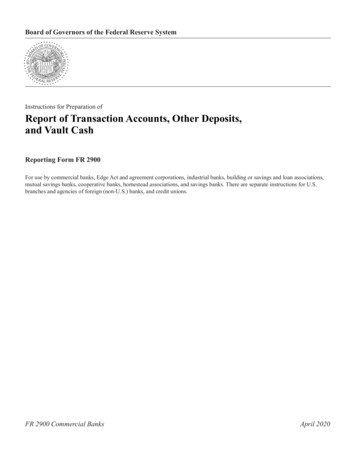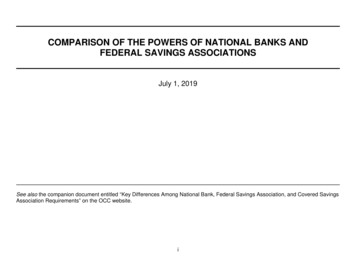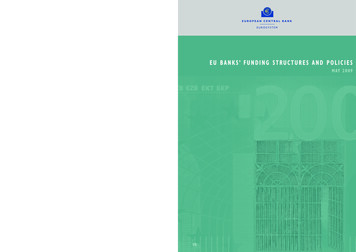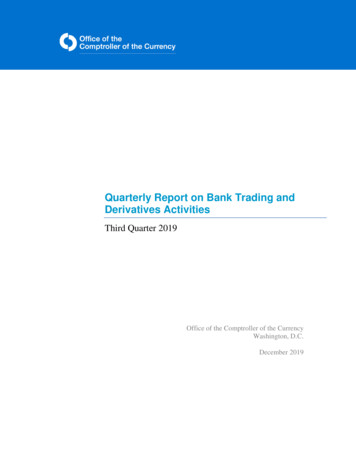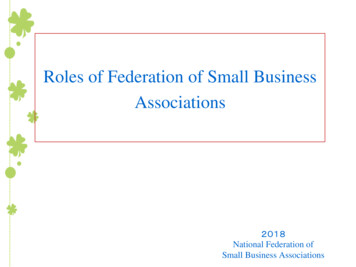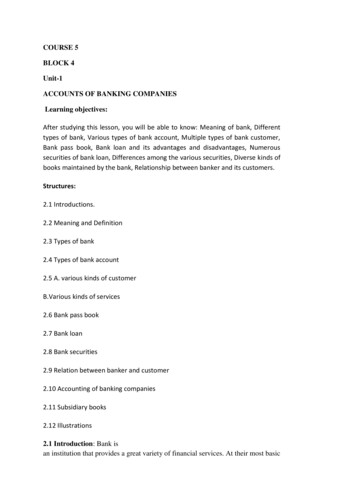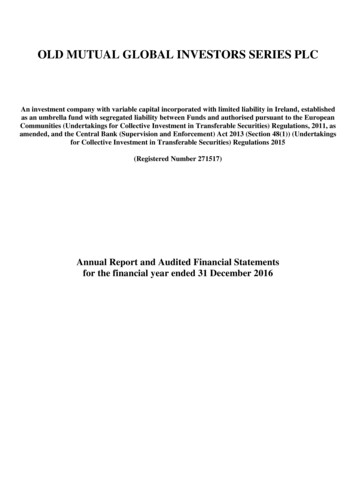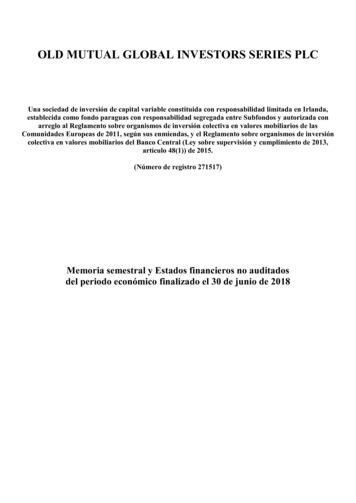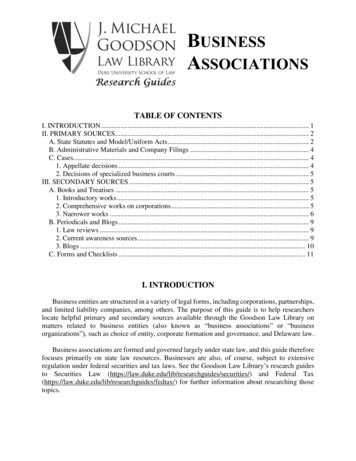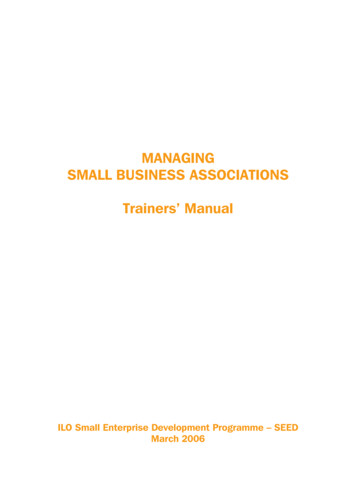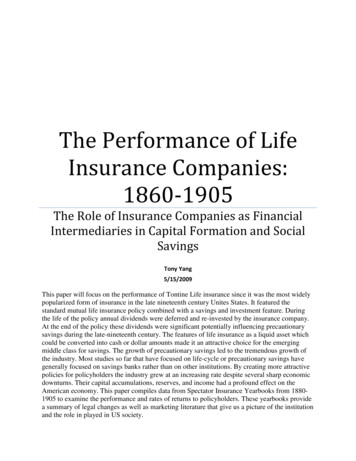
Transcription
!!" #This paper will focus on the performance of Tontine Life insurance since it was the most widelypopularized form of insurance in the late nineteenth century Unites States. It featured thestandard mutual life insurance policy combined with a savings and investment feature. Duringthe life of the policy annual dividends were deferred and re-invested by the insurance company.At the end of the policy these dividends were significant potentially influencing precautionarysavings during the late-nineteenth century. The features of life insurance as a liquid asset whichcould be converted into cash or dollar amounts made it an attractive choice for the emergingmiddle class for savings. The growth of precautionary savings led to the tremendous growth ofthe industry. Most studies so far that have focused on life-cycle or precautionary savings havegenerally focused on savings banks rather than on other institutions. By creating more attractivepolicies for policyholders the industry grew at an increasing rate despite several sharp economicdownturns. Their capital accumulations, reserves, and income had a profound effect on theAmerican economy. This paper compiles data from Spectator Insurance Yearbooks from 18801905 to examine the performance and rates of returns to policyholders. These yearbooks providea summary of legal changes as well as marketing literature that give us a picture of the institutionand the role in played in US society.
American economic activity in post Civil War America displayed tremendous growthand social upheaval. Life insurance companies mirrored the same type of volatility as majorindustries in the United States. In the antebellum period, life insurance was composed of a groupof ad-hoc companies centered on the Northeastern United States. These companies weregenerally located in the Baltimore and Philadelphia areas. Early laws governing the behavior oflife insurance companies required that they maintained high reserve levels to insurepolicyholders [Murphy 2005:223] Early insurance incorporation laws required these highreserves as a way to ensure financial stability [Murphy 2005: 203].It wasn’t until legal changes spearheaded by insurance companies in Pennsylvania andNew York in the 1860s changed the way insurance companies could be formed. Due to the highrequirements for reserve levels insurance companies often had to sell stock and shares of thecompanies in order to raise the cash necessary to back up the values of their insurance policies.To give these shareholders an incentive to invest, insurance policies had to be sold at a costsufficient to make the company highly profitable. By lowering the reserve requirements, lifeinsurance companies not only allowed more life insurance companies enter the market, but forthe insurance companies could be structured differently. The Panic of 1819 affected the industrynegatively as states sought to restrict insurance companies and their policies. Insurancecompanies along with banks had overleveraged themselves and quickly became insolvent aspeople began to default on their policies and remove their deposits. Many states, New York inparticular, sought to prevent fraud and abuse from what they viewed as a risky business.Chartering new insurance companies became extremely difficult, since the startup costs wereprohibitively high. Companies had to use stock and shares to raise the capital necessary tomaintain the high reserve requirements for business. Few insurance companies would be2
incorporated as shared stockholder companies because of the stringent regulations enacted atafter the Panic of 1819. However, mutual insurance which had lower capital reserverequirements, thus negating the need for high capital accumulation, began to expand. This formof insurance proved highly popular with those buying insurance since policyholders had addedbenefits when compared to non-mutual insurance.Mutual insurance operated by providing dividend payments to policyholders. Previouslythe only benefit policyholders purchased was the value of the policy. Under mutual insurance,individuals would receive dividend payments, because in theory, the policyholder was astakeholder in the company [Murphy 2005: 180]. Under the previous insurance regimes,policyholders could only receive a death benefit, in part because of the higher reserverequirements before 1840. Since the old insurance companies had to hold much more money fora reserve, they could not provide a dividend for policyholders. The shareholders, who had raisedthe capital to start the insurance company, would receive payouts, but not policyholders. Thisoften limited the attractiveness of insurance to individuals in the upper echelon of society. In theAntebellum period life insurance was purchased mostly for individuals who were either collegestudents or travelers.Most early colleges were private institutions and required a fair amount of monetaryinvestment from the family to send their son to college. Insuring the life of a son away at collegewas critical. Typically, young men are at higher risk for death or injury, particularly away atcollege. The enormous amount of money invested in the son’s education required insuranceagainst this risk [Stalson 1942: 107]. Another common category of policyholders were travelers.During the ante-bellum period, travel in the United States was haphazard. Crossing vastgeographic regions took days, weeks, and even months, particularly if they were trying to get3
goods to market. This required some insurance against the loss of goods or life while traveling.This left life insurance as a specialized financial service that only catered to the upper strata ofsociety. Insurance policies became much more prolific after the advent of mutual insurance. Notonly was the dividend feature attractive, but the increasing number of companies forced downpremiums and made insurance available to a wider segment of society. Mutual insurancecompanies are easily formed since they used annual premiums to cover life insurance policylosses during the course of the year [Stalson 1942: 110]. If a sufficient number of policies couldbe sold the annual premiums would be able to cover potential losses in any given year, allowingthe company to hold a reserve that could be invested with the returns from those investeddistributed to policyholders annually. The intuition for organizing a company along mutual lineswas that it did not require the level of capital that older companies needed to insure each policy.Legal changes in most states required joint-stock insurance companies to have higher reserverequirements than mutuals [Murphy 2005:207]. Mutual companies argued that if they couldreasonably calculate deaths and payouts per year they could manage payouts to policyholderswithout the need of larger reserves. The reserves would be drawn from the annual premiumswhich when priced, would incorporate the required reserved amount by law, typically at threepercent of the value of the policy.Life insurance companies felt that it was highly unlikely that a sufficient number ofindividuals would die in one year to make the insurance company insolvent, as long as policieswere sold to the right individuals. If they developed effective sorting mechanisms they couldlimit risks to the company. Life insurance agents became critically important since the companywould rely on them to evaluate the risk of insuring an individual. This however, did not insulatethe companies from the problems of the economy. The Panic of 1873 in particular would force4
many companies out of business as deteriorating financial conditions created solvency problemsfor many of the smaller life insurance companies.Figure 1.11Figure 1.1 shows the result of the Panic of 1873. The resulting exit of companies effectivelypurged the insurance industry of marginal providers. The remaining companies survived sincethey had larger reserves and surpluses than other companies. The surviving companies also had aunique feature, they all offered tontine insurance.The initial growth of mutual insurance from 1840-1860 was minimal and most likelyreflected limited demand for life insurance and general legislative hostility towards life insurancecompanies [Murphy 2005: 24]. However, in the period after 1865 the number of policies in forcegrew exponentially as well as the number of companies. Figure 1.1 shows the rise in the number1Figure 1.1 is compile using Table Table Cj713 in, Historical Statistics of the United States, Earliest Timesto the Present: Millennial Edition, edited by Susan B. Carter, Scott Sigmund Gartner, Michael R. Haines, Alan L.Olmstead, Richard Sutch, and Gavin Wright. New York: Cambridge University Press, 2006.5
of insurance companies in shortly after the Civil War. While many of these companies did notsurvive the severe economic disruption of the Panic of 1873, there was at least a net increase inthe number of companies that provided life insurance. However, the number of companies is notindicative of the growth of life insurance.As we see in figure 1.2, the values of the policies in force grew exponentially.2The companies that survived the Panic of 1873 underwrote most of the growth in newbusiness. While Owen Stalson attributes much of the rise in life insurance to the heavy marketingand organization of the life insurance companies, it seems more likely that there is an increasingdemand for life insurance. Livi Di Mateo and J.C. Herbert Emery studied the correlation betweenwealth and life insurance in Ontario, Canada for 1892. They found a strong negative correlationbetween wealth and life insurance. They concluded that life insurance was particularly indemand by segments of the population with little wealth since they had little accumulated2Figure 1.2 is compiled from Table Cj715 in Historical Statistics of the United States, Earliest Times to thePresent: Millennial Edition, edited by Susan B. Carter, Scott Sigmund Gartner, Michael R. Haines, Alan L.Olmstead, Richard Sutch, and Gavin Wright. New York: Cambridge University Press, 2006.6
reserves [De Matteo and Emery 2002]. The upper echelon of society who had accumulatedsubstantial assets in the form of land, cash, businesses, etc could easily provide for theirfamilies in the event of their death. Demand for life insurance increases in part due to theindustrialization of society. Wage workers were far more insecure in terms of their economicwell-being than farmers. Living on wage income meant protecting oneself against a loss inwages. In a single breadwinner household, this became very important. Coupled with familialresponsibilities men and women increasingly sought economic protection for their spouses andespecially children in the event of the loss of a spouse. It is important here to note that lifeinsurance most often was purchased by middle-class Americans. The rise of the middle class inthe United States and the rise of life insurance are strongly correlated. Purchasing life insuranceexemplified a precautionary savings motive. It insured against lost income in the event of death,while the surplus and dividend accumulated by purchasing life insurance could earn interest. Theincreasing tendency for social savings in the form life insurance represents the sensitivity offamilies to the loss of income while also representing a modest life cycle saving behavior. Wecan view life insurance as a life-cycle institution since one conceivably invests in endowment,annuities, or paid up insurance as returns once a policy matures. The development of surrendervalues ensured that policyholders under stress to get some return on their investment.Life insurance worked in concert with the expansion of mutual savings banks to offer avariety of new financial services to the population. Like mutual savings banks, mutual lifeinsurance companies catered to wider strata of society, but paying dividends from accumulatedreserves and death benefits instead of holding savings deposits. Unlike mutual savings banks theannual premiums required by insurance companies made life insurance difficult to purchase byaverage workers. Indeed most annual premiums per 1000 ran from 21.49 to 43.34 from 18967
to 1908 for a man aged 25 from Equitable Insurance of New York at the point of issue.3 Theserates varied due to the different policies an individual could buy. Rates increased as ageincreased, since the risk of death was much higher. By the time a man was aged 55 if he so choseto take out a twenty year life policy would pay annual premiums raged from 60.72 to 70.51.While these premiums represented a general reduction from life insurance before the Civil War,they were not insignificant amounts of money. Average annual non-Farm income increased from 453 to 577 during the same time period.4 In relative terms since insurance premiums werefixed, income increasing and both affected by a general deflation of the nineteenth century, lifeinsurance was becoming vastly more affordable. It clearly wasn’t so affordable that paying theannual premium was not a serious financial decision.Mutual companies operated with lower reserve requirements than joint stock companiesrisk assessment and actuarial soundness became critical for mutual insurance companies.Operating under the mutual model allowed for cheaper policies since the reserve was held as aportion of the premiums, instead of being a fixed cost associated with having to raise capitalthrough some other means to underwrite insurance policies. Insurance companies could nowunderwrite policies based on the number of policyholders paying their premiums on time.Lowering costs increased the demand for life insurance and prompted two important innovationsin the life insurance industry The first innovation was the advent of the America Life Table ofMortality developed by Sheppard Homans in 1868 [Murphy 2005:81]. Murphy writes:Throughout the nineteenth century the America life insurance industry privatelystruggled to understand the risk at the core of its existence, while privately31914Spectator Company (New York), Annual and deferred Dividends, Spectator Company, New York, NY,4Table Ba4280-4282, Historical Statistics of the United States, Earliest Times to the Present: MillennialEdition, edited by Susan B. Carter, Scott Sigmund Gartner, Michael R. Haines, Alan L. Olmstead, Richard Sutch,and Gavin Wright. New York: Cambridge University Press, 20068
struggled to understand the risk at the core of its existence, while publicly toutingthe scientific rigor supposedly underlying the permanent and financial stability oflife institutions.Sheppard Homans was the chief actuary of Mutual Life Insurance based in New York, and heundertook the task of calculating the expected rate of deaths based upon Mutual’s experience.Life insurance companies before Homans’ table were plagued often with inaccurate data inconstructing their own life tables. They often relied on the British experience, which clearly bythe mid-nineteenth century had deviated enough from what the United States experienced. Thismeant that a critical revision of the life tables used to determine premium rates for insurancecompanies had to be revised.Since death is certain for everyone, insurance companies required accurate measures inorder anticipate expenses and payouts as part of their operating costs. Mutual and Homansworked quite hard in making the life table that he constructed the industry standard. It eventuallybecame the legal standard in the state of New York. Most of the companies who were industryleaders and chartered in New York quickly adopted this table. The American ExperienceMortality table proved to be more accurate than the previous life tables that were different foreach company. This standardization and legal codification of the Homans’ table made theindustry uniform. By having a uniform set of actuarial tables the insurance industry could settheir rates in a more uniform fashion. It helped the industry as a whole predict the costs acompany could expect in resulting from payouts due to deaths, defaults on payments, and othercosts associated with new business. It helped to stabilize the fierce competition in the insuranceindustry, and made the industry relatively sound financially. By having uniform actuarialstandards, the state of New York set ground rules for new companies and how they werefinancially managed.9
Like all financial firms Life Insurance companies are institutions that leveraged theirreserves and accumulations for the benefit of their policyholders. In theory the money held bythe insurance company was available to policy holders upon the death of the insured. Thisallowed insurance companies to accumulate capital at very high rates. But it also requiredaccurate actuarial tables by the insurance companies to make sure that death, default, and lapseswere accounted for. Under anticipating losses would cripple an insurance firm’s ability to pay itslosses and therefore make the firm insolvent. Overestimating losses would reduce the insurancefirm’s ability to invest surpluses and limit returns to investors. Homans’ table of Mutual’sexperience with life insurance allowed a much more accurate prediction of losses and costs in theinsurance industry. While Homans’ table is crude, particularly in regard to later actuarialmethods, it was an advance since it was the first table to attempt to describe American behavior.Homans’ table was the minimum and most conservative actuarial table upon which insurancecompanies could base their financing upon. State requirements for insurance company reserveshad to be based upon the American Experience Life Table.This table while providing a basis for financial planning did not disallow insurancecompanies from making their own predictions and judgment based upon their own experience. Inparticular Equitable Life insurance would alter Homan’s table to anticipate much more favorablepredictions of its returns that would actually occur. Equitable would also assume a higher lapserate than it actually experienced. Homans’ table helped to anticipate costs and helped investmentdecisions by insurance companies but actual economic conditions would vary. Economicdownturns, changes in the insurance industry, and changes in social policy would impact howaccurate the actuarial tables would be in predicting future business costs and returns.10
An equally important innovation was the development tontine insurance in the 1860s byEquitable Insurance Company of New York. Equitable’s tontine insurance was so popular thatby the end of the nineteenth century most insurance in force was based on the tontine deferreddividend plan. Originally the tontine was developed by Lorenzo Tonti in 17th century France.Tonti’s plan was built in was borne out of the need to raise massive amounts of money forFrench militarism. The tontine operated by pooling capital investments by several individualstogether and then investing them together in a giant fund. Depending on the various types oftontine fund annual dividends could be paid out to holders of the tontine [North 1952: 6]. Thesurvivor or survivors, depending upon how the tontine was structured, would not only havereceived annuity payments but a share of the remaining initial capital investments from theoriginal investment.In the United States the development of tontine insurance occurred after the Civil War.The life insurance industry in the nineteenth century United States was and still is mostly stateregulated. This led toward some differences in the industry, but insurance companies for themost part mirrored one another. Equitable insurance company was the first company toaggressively market tontines to the general population.The tontine plans required annual premiums for policyholders. Also named as tontinesavings plans, it combined life insurance with the tontine principle. An individual is insured forthe amount that was on the policy. Upon their death they could not receive the accumulatedsurplus unless the policy had matured and they had survived the tontine policy period. Equitableinitially led the industry in offering tontines because of the difficulties it had in competing withMutual Insurance Company. Mutual had larger surpluses that were being distributed to itspolicyholders trying to undercut Equitable. This particular innovation was the result of intense11
competition in the New York life insurance industry. Henry B. Hyde the founder and presidentof Equitable Insurance engaged in an insurance war with the Mutual Life insurance company.Not only were both companies slashing premiums rates, they competed for sales agents, andwaged pitched battles in the press. Mutual attempted to drive Equitable out of business byoffering what had been up to then unheard of, annual dividends from the insurance surplus.Equitable being a newer company had a significantly smaller surplus and would be vulnerable toa run on its surplus [Buely 1959, 150].Ever since the 1850s mutual insurance companies came to dominate the industry sincethey offered dividend to their policyholders. Mutual insurance companies had a benefit for policyholders in that policy holders were also share holders in the company and were entitled todividends on investments and surpluses that the company generated. Insurance laws generallyallowed insurance companies to determine their own timetable for declaring dividends andsurpluses, usually in five year periods. In advertising annual dividends Mutual attempted to forcea run on Equitable’s surpluses. The amount of surpluses for insurance companies, that is moneyin excess of expenses incurred in operating insurance, were advertised as symbols of health andstrength of insurance companies. Equitable stopped the run on its surpluses by deferring surpluspayments through the use of tontines [Buley 1959: 145].Tontines account for the vast majority of insurance sales through 1905. Ransom andSutch contend that tontine insurance was an innovation for accruing assets for old age [Ransomand Sutch 1987: 379]. It serves as a tremendous life-cycle asset for the individuals who couldbuy it. The interesting thing to consider about tontines is just how broad the tontines were in theirappeal to all segments of society. While the impoverished could never really afford to save forold age, an increasing segment of the middle class, and professionals began to save through this12
plan. In fact company memos detail the marketing of tontines towards Pastors and clergymembers, as a way to make tontines more respectable.The tontines provided a method for savings in retirement. In the era before nationalbanking insurance companies were some of the largest national financial institutions. Lifeinsurance companies represented safe savings institutions. The tontines and life insurance provedso prolific that an estimated third of the American population held policies. Tontines could alsoproduce better rates of returns over mutual savings banks and constituted most of the newpolicies written after 1880. Mutual savings banks averaged 4.5% rates of return while the rate ofreturn from tontines from 1871- 1891 are around a nominal rate of 6.5% which not only wassignificantly higher, but in an era of falling prices represented a real growth of wealth throughsavings [Ransom and Sutch, draft 1986: 20].Tontine insurance differed from normal level premium life insurance since the policysurplus would be reinvested by the company for the policyholder and disbursed at the end of theterm not throughout. Henry Baldwin Hyde, working with Sheppard Homans the chief actuary ofMutual, developed tontine life insurance. It would operate under various titles with otherinsurance companies. Hyde and Equitable aggressively marketed tontines as a form of savingsrather than simply a form of insurance. Tontine savings plans combined life insurance with thetontine principle. The individual policyholder is insured for the amount that was on the policy.Upon their death the beneficiaries would receive the amount on the policy. They could not,however, receive the accumulated surplus. Policy holders would receive a surplus/dividend oncethe policy had matured and survived the tontine policy period. By delaying the payment of thepolicyholders’ surplus/dividend Equitable’s surplus remained intact despite pressure fromMutual. Though Equitable stopped the run on its surpluses by deferring surplus payments13
through the use of tontines, this form of insurance initially performed poorly [Van Cise 1895:6].5 Some changes were made to the tontine insurance plans in order to attract more customers.The policy on lapse and defaulting on the insurance planned proved to punitive to potentialpolicy holders. Instead Homans and Hyde, revised the program, allowing individuals at setperiods to draw the surplus in cash, as well as be given a surrender value [Van Cise 1895: 9].The Semi-Tontine incentive allowed policyholders some financial leeway without losing theirentire investment if they could not afford and annual payment since they could have a policysurrender value. That way if a policy lapses there is the option of either taking paid up assuranceor the cash surrender value on the policy. Rather than locking a person into a twenty yearcommitment this gave room in case of exigent circumstances. Semi-Tontines came to representnearly all the policies written in the United States [Van Cise 1895: 17].Tontine insurance works by deferring the dividends that policyholders would normallyreceive annually. Under normal term life insurance the policyholder would receive dividends thatare disbursed at some pre-determined period during the life of the contract usually five years.Under tontine insurance annual dividends were withheld and reinvested by the company whichwould give the policyholder a higher rate of return than under normal term insurance for theduration of the policy. In addition, to the reinvested dividend that the policyholder would receivewhen the policy matured, the policyholder would receive the differed dividend of those whodefaulted on their policy and the surplus of those who died under the policy. In addition to thepaid up cash value of the policy the ultimate payout of the policy after twenty years would bequite significant. This was the major selling point of the life insurance policies, returns from thetontine policies offered significantly better rates of returns. Tontine policies often were5Van Cise, Joel G., History of the Tontine Poicies Issued by the Equitable Life Assurance Society, AxaEquitable Archives, New York, New York, 1890, 1414
advertised using projected returns that were calculated using Sheppard Homans’ AmericanExperience Mortality table. The mortality table was then combined interest rate and the rate thatpolicyholders among a certain cohort would default on.From the Armstrong Committee reports on the insurance industry in 1905, we can seethat Homans’ table calculated not only the death rate but also the expected lapse rates for specificcohorts of policyholders [Armstrong Committee 1905: 913]. These projections primarily were toallow the insurance industry to project costs well in advance, but under the tontine plan, theprojections could help predict return rates for policyholders. Homans based his returncalculations in four parts. The first was that invested funds would earn an interest rate of sixpercent. He assumed mortality would be low and that eighty percent of the mortality table sincemedical screening would remove bad risks. Company expenses he predicted would be constantand a fraction of the premium. This meant that the dividend would also be constant. Lastly,Homans assumed that lapses in premium payments resulting in default would be constant [VanCise 1895:30].While the projected payments of the period were very generous and useful as a marketingtool, many policyholders would be disenchanted with the actual performance of the policy. Thepolicies underperformed when compared to the initial projections during the point of sale. Whencalled to testify before the committee Joel Van Cise, the chief actuary of Equitable insurancecompany, attempted to explain the reason for the large disparity between advertised potentialreturns and actual returns. Van Cise argued that the largest reason for the disparity in theprojected returns and the actual returns was largely due to the decline in prevailing interest rates.The following table is taken from Historical Statistics of the United States table Cj1250.15
Figure 1.3 Prevailing Interest RatesThis demonstrates Van Cise’s contention that the projections Homan’s had developed inthe 1870s did not reflect actual business conditions was correct. Homans’ assumption of a sixpercent continuous interest rate was significantly off. This period in American history had anaverage interest rate closer to 4.5 percent. Homans’ assumptions of a favorable interest rate topolicyholders were not corrected. Advertisements and projections for tontine insurance still usedHomans’ calculations in the 1880s and 1890s that were created under more optimistic businessconditions in the 1870s. Clearly the insurance companies knew that lower insurance rates wereaffecting the returns. Van Cise was privately, deeply concerned about the generous results thetontine rate books used for marketing purposes [Van Cise 1895: 19].Equitable insurance company in 1889 issued a note to agents on how to handleestimates.6 Agents were encouraged to provide estimates based on their knowledge particularly6Equitable Insurance Company, Note to Agents No.59, Axa-Equitable Archives16
while canvassing for new business. Insurance agents were for the most part employed throughsoliciting agents. Agents were often recruited from other insurance companies and withoutregard to much formal training. Insurance agents would often be seen collecting insurancepremiums at the local ba
standard mutual life insurance policy combined with a savings and investment feature. During the life of the policy annual dividends were deferred and re-invested by the insurance company. At the end of the policy these dividends were significant potentially influencing precautionary savings during the late-nineteenth century.
